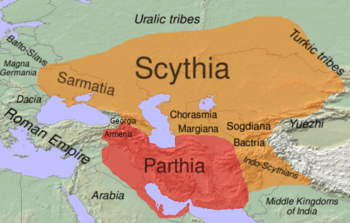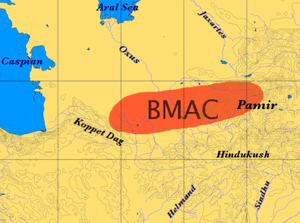List of ancient Iranian peoples

This list of ancient Iranian peoples includes names of Indo-European peoples speaking Iranian languages or otherwise considered Iranian in sources from the late 1st millennium BC to the early 2nd millennium AD.
Background

The Iranian languages form a sub-branch of the Indo-Iranian sub-family, which is a branch of the family of Indo-European languages. Having descended from the Proto-Indo-Iranians, the Proto-Iranians separated from the Indo-Aryans early in the 2nd millennium BCE. The Proto-Iranians are traced to the Bactria–Margiana Archaeological Complex, a Bronze Age culture of Central Asia. The area between Afghanistan and the Aral Sea is hypothesized to have been the region in which the Proto-Iranians first emerged, following the separation of Indo-Aryan tribes.[1]
Iranian peoples first appear in Assyrian records in the 9th century BCE. In Classical Antiquity, they were found primarily in Scythia (located in Central Asia, Eastern Europe and northern Caucasus) and Persia (in Western Asia). They divided into "Western" and "Eastern" branches from an early period, roughly corresponding to the territories of Persia and Scythia, respectively. By the 1st millennium BCE, Medes, Persians, Bactrians and Parthians populated the Iranian plateau, while others such as the Scythians, Sarmatians, Cimmerians and Alans populated the steppes north of the Black Sea and the Caspian Sea. The Saka tribes remained mainly in the far-east, eventually spreading as far east as the Ordos Desert (North-Central China).
During Late Antiquity, the Iranian populations of Scythia in the Eurasian Steppe were marginalized and assimilated by Germanic Slavic and Turkic migrations. By the 10th century, the Eastern Iranian languages were no longer spoken in many of the territories they were once spoken, with the exception of Pashto in Central Asia, Ossetic in the northern Caucasus and other minor languages in Badakhshan. Various Persian empires flourished throughout Antiquity, and fell to the Islamic conquest in the 7th century.
List
- West Iranian
- Persians
- Medes
- Parthians
- Pallavas, probably descended from Parthian invaders of South Asia[2]
- Arians
- Sagartians (whose name survives in the name of the Zagros Mountains)
- Corduchi [3]
- Cyrtii (mentioned by Strabo and possible ancestor of Kurds according to Muhammad Dandamayev) (See Carduchi in Encyclopædia Iranica)
- Caspians[4]
- Cadusii[5]
- Leucosyri (White Syrians)
- East Iranian
- Bactrians
- Arachosians
- Khwarezmians
- Sogdians, possible ancestors of Yaghnobis
- Dahaes
- Zarangians
- Scytho-Sarmatian
- Scythians
- Sarmatians, including the Rhoxolani, Iazyges, Siraces, possible ancestors of Slavs
- Alans (sometimes considered a branch of the Sarmatians), possible ancestors of Ossetians
- Roxolani, an Alan subgroup
- Arimaspi
- Saka
- Parama Kambojas, of the Alay Valley or Alay Mountains, north of Hindukush. In ancient Sanskrit texts, their territory was known as Kumudadvipa and it formed the southern tip of the Sakadvipa or Scythia. In classical literature, this people are known as Komedes. Indian epic Mahabharata designates them as Parama Kambojas[6]
- Parni
- Massagetae
- Kambojas (an Avestan speaking group of East Iranians living in what is now Afghanistan)[7][8][9]
- Ashvakas: Scholars link the historical Afghans (modern Pashtuns) to the Ashvakas (the Ashvakayanas and Ashvayanas of Pāṇini or the Assakenoi and Aspasio of Arrian). The name Afghan is said to have derived from the Ashvakan of Sanskrit texts.[10][11][12] Ashvakas are identified as a branch of the Kambojas
Possible Ancient Iranian peoples whose designation is uncertain
- Cimmerians (ethnicity as Iranians specifically unknown)
- Sigynnae (uncertain, known only by obscure reports)
- Xionites (uncertain, known only by obscure reports)
- Hephthalites (uncertain, but highly probable)
See also
- List of Celtic tribes
- List of Germanic peoples
- List of ancient Italic peoples
- List of Ancient Greek tribes
- List of Rigvedic tribes
References
- ↑ "The Paleolithic Indo-Europeans"—Panshin.com (retrieved 4 June 2006)
- ↑ Venkayya 1907, p.219-220
- ↑
- ↑ Rüdiger Schmitt in Encyclopædia Iranica, s.v. "Caspians"
- ↑ Rüdiger Schmitt, "Cadusii" in Encyclopædia Iranica
- ↑ Mahabharata 2.27.25.
- ↑ Scholars like V. S. Aggarwala etc locate the Kamboja country in Pamirs and Badakshan (Ref: A Grammatical Dictionary of Sanskrit (Vedic): 700 Complete Reviews.., 1953, p 48, Vasudeva Sharana Agrawala, Surya Kanta, Jacob Wackernagel, Arthur Anthony Macdonell, Peggy Melcher - India; India as Known to Pāṇini: A Study of the Cultural Material in the Ashṭādhyāyī, 1963, p 38, Vasudeva Sharana Agrawala - India; The North-west India of the Second Century B.C., 1974, p 40, Mehta Vasishtha Dev Mohan - Greeks in India; The Greco-Sunga period of Indian history, or, the North-West India of the second century B.C, 1973, p 40, India) and the Parama Kamboja further north, in the Trans-Pamirian territories (See: The Deeds of Harsha: Being a Cultural Study of Bāṇa's Harshacharita, 1969, p 199, Vasudeva Sharana Agrawala).
- ↑ Dr Michael Witzel also extends Kamboja including Kapisa/Kabul valleys to Arachosia/Kandahar (See: Persica-9, p 92, fn 81. Michael Witzel).
- ↑ Cf: "Zoroastrian religion had probably originated in Kamboja-land (Bacteria-Badakshan)....and the Kambojas spoke Avestan language" (Ref: Bharatiya Itihaas Ki Rup Rekha, p 229-231, Jaychandra Vidyalankar; Bhartrya Itihaas ki Mimansa, p 229-301, J. C. Vidyalankar; Ancient Kamboja, People and the Country, 1981, p 217, 221, J. L. Kamboj)
- ↑ "The name Afghan has evidently been derived from Asvakan, the Assakenoi of Arrian..." (Megasthenes and Arrian, p 180. See also: Alexander's Invasion of India, p 38; J. W. McCrindle)
- ↑ "Even the name Afghan is Aryan being derived from Asvakayana, an important clan of the Asvakas or horsemen who must have derived this title from their handling of celebrated breeds of horses" (See: Imprints of Indian Thought and Culture abroad, p 124, Vivekananda Kendra Prakashan)
- ↑ "Afghans are Assakani of the Greeks; this word being the Sanskrit Ashvaka meaning 'horsemen" (Ref: Sva, 1915, p 113, Christopher Molesworth Birdwood)
Literature
- H. Bailey, "ARYA: Philology of ethnic epithet of Iranian people", in Encyclopædia Iranica, v, pp. 681–683, Online-Edition, Link
- A. Shapur Shahbazi, "Iraj: the eponymous hero of the Iranians in their traditional history" in Encyclopædia Iranica, Online-Edition, Link
- R. Curzon, "The Iranian Peoples of the Caucasus", ISBN 0-7007-0649-6
- Jahanshah Derakhshani, "Die Arier in den nahöstlichen Quellen des 3. und 2. Jahrtausends v. Chr.", 2nd edition, 1999, ISBN 964-90368-6-5
- Richard Frye, "Persia", Zurich, 1963
| ||||||||||||||||||